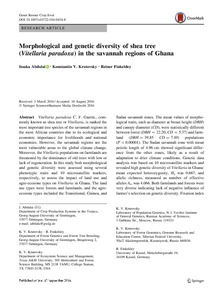Показать сокращенную информацию
Morphological and genetic diversity of Shea tree (Vitellaria paradoxa) in the Savannah regions of Ghana
| Автор | Abdulai, I. | |
| Автор | Krutovsky, K. V. | |
| Автор | Finkeldey, R. | |
| Дата внесения | 2017-06-16T10:24:35Z | |
| Дата, когда ресурс стал доступен | 2017-06-16T10:24:35Z | |
| Дата публикации | 2016-09 | |
| Библиографическое описание | Abdulai, I. Morphological and genetic diversity of Shea tree (Vitellaria paradoxa) in the Savannah regions of Ghana [Текст] / I. Abdulai, K. V. Krutovsky, R. Finkeldey // Genetic Resources and Crop Evolution. — 2016. — С. 1-16 | |
| ISSN | 09259864 | |
| URI (для ссылок/цитирований) | https://elib.sfu-kras.ru/handle/2311/32965 | |
| Описание | Текст статьи не публикуется в открытом доступе в соответствии с политикой журнала. | |
| Аннотация | Vitellaria paradoxa C. F. Gaertn., commonly known as shea tree or Vitellaria, is ranked the most important tree species of the savannah regions in the most African countries due to its ecological and economic importance for livelihoods and national economies. However, the savannah regions are the most vulnerable areas to the global climate change. Moreover, the Vitellaria populations on farmlands are threatened by the dominance of old trees with low or lack of regeneration. In this study both morphological and genetic diversity were assessed using several phenotypic traits and 10 microsatellite markers, respectively, to assess the impact of land use and agro-ecozone types on Vitellaria in Ghana. The land use types were forests and farmlands, and the agro-ecozone types included the Transitional, Guinea, and Sudan savannah zones. The mean values of morphological traits, such as diameter at breast height (DBH) and canopy diameter (CD), were statistically different between forest (DBH = 22.20, CD = 5.37) and farmland (DBH = 39.85 CD = 7.49) populations (P < 0.00001). The Sudan savannah zone with mean petiole length of 4.96 cm showed significant difference from the other zones, likely as a result of adaptation to drier climate conditions. Genetic data analysis was based on 10 microsatellite markers and revealed high genetic diversity of Vitellaria in Ghana: mean expected heterozygosity, He was 0.667, and allelic richness, measured as number of effective alleles Ae, was 4.066. Both farmlands and forests were very diverse indicating lack of negative influence of farmer’s selection on genetic diversity. Fixation index was positive for all populations (mean FIS = 0.136) with farmlands recording relatively higher values than forests in all ecological zone types studied, probably indicating less gene flow in the farmlands. Moderate differentiation (F′ST = 0.113) was comparable to other similar tree species. Both land use and ecological zone types influenced genetic differentiation of Vitellaria at varying levels. The species was spatially structured across three ecozones and following climatic gradient. The forest reserves are used in situ conservation for Vitellaria in Ghana. High diversity observed in the most arid zones provides opportunity to find and use appropriate plant materials for breeding climate change resilient trees. | |
| Ссылка на другой сайт | http://link.springer.com/article/10.1007/s10722-016-0434-8 | |
| Тема | Fixation index | |
| Тема | Genetic diversity | |
| Тема | Heterozygosity | |
| Тема | Microsatellite | |
| Тема | Savannah | |
| Тема | Vitellaria paradoxa | |
| Название | Morphological and genetic diversity of Shea tree (Vitellaria paradoxa) in the Savannah regions of Ghana | |
| Тип | Journal Article | |
| Тип | Published Journal Article | |
| Страницы | 1-16 | |
| ГРНТИ | 34.23 | |
| Дата обновления | 2017-06-16T10:24:35Z | |
| DOI | 10.1007/s10722-016-0434-8 | |
| Институт | Институт фундаментальной биологии и биотехнологии | |
| Подразделение | Базовая кафедра защиты и современных технологии мониторинга лесов | |
| Журнал | Genetic Resources and Crop Evolution | |
| Квартиль журнала в Scopus | Q2 | |
| Квартиль журнала в Web of Science | Q2 |

